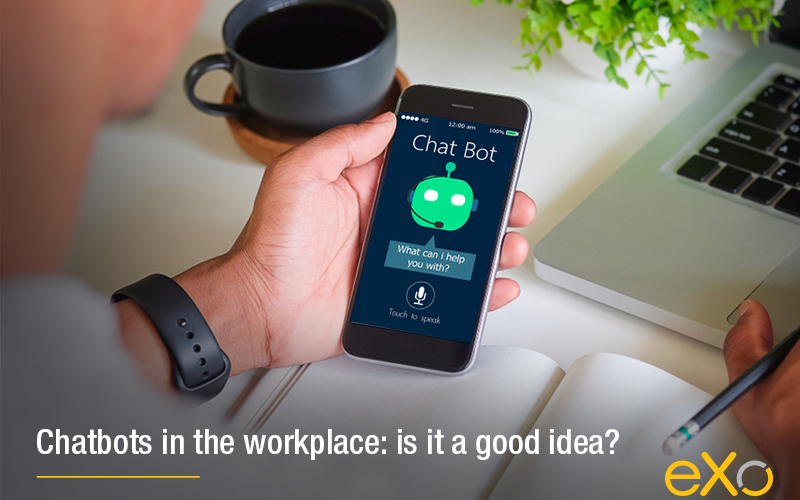- Fares Laroui
- July 22, 2019
Chatbots in the digital workplace: Is it a good idea?

Content
1. What is a chatbot and how do you use it for your business?
- What is a chatbot? Investopedia’s definition of chatbots consider them as a computer program and an AI feature capable of simulating human conversations through voice and text commands or both. Chatbots can be integrated into messaging apps, websites and operating systems. You can create your own chatbot using chatbot builder software such as Appy Pie Chatbot.
- Who is it for? The ability of chatbots to engage in human-like conversations with users has made them the solution of choice for companies to eliminate routine operations and repetitive requests and improve customer experience. Chatbots are available for different fields and operations like customer support, sales and marketing, banking, food delivery and more.
- How is it used? Regardless of the type of chatbot (basic or smart), the usage is more or less the same. A user asks a question and the chatbot or virtual assistant tries to provide the most useful answer. In the case of basic chatbots, the answers are already predefined for specific keywords. For example, if a user types ‘blue shoes’ and the chatbot is programmed to recognise that keyword, it will answer by providing a list of blue shoes. If that is not the case, it will display a generic answer like ‘I did not understand your question’. In contrast, smart chatbots are based on AI, which makes them able to record and learn from past conversations to provide accurate recommendations and answers.
engagement and performance
2. Four ways to use chatbots
3. Use cases for chatbots
Facilitating access to information
Customer support and help desk
Customer support and help desk are the customer-facing portal of any business. End users have been relying on traditional communication tools to get in touch with support teams, such as phones, emails and face-to-face contact. However, chatbots provide businesses with the opportunity to streamline this process by handling the initial point of contact, eliminating repetitive requests and freeing the workforce to concentrate on more important tasks.
Businesses that are short on support agents nowadays can outsource live chat to service providers like Deskmoz or Simpu which provides full-time in-house staff to provide 24/7 chat support to ensure that no opportunity gets missed ever. Being programmed to answer FAQs and handle simple requests, chatbots can significantly reduce waiting time as they provide answers instantly, 24/7.
Scheduling meetings and conferences
Chatbots and virtual assistants can be used to simplify daily activities. Controlling conferencing systems and scheduling meeting rooms are made easy with virtual assistants like Amazon’s Alexa for Business and others. The capacity of such bots to recognise human voice and to integrate with multiple systems like video conferencing and office suites makes them a powerful tool to facilitate day-to-day tasks.
Enhancing the recruitment process

FREE WHITE PAPER
Types of Digital workplace solutions
The modern workplace has evolved significantly in recent years, with advancements in technology, the growing number of tools …
Related posts
- All
- eXo
- Digital workplace
- Employee engagement
- Open source
- Future of work
- Internal communication
- Collaboration
- News
- intranet
- workplace
- Knowledge management
- Employee experience
- Employee productivity
- onboarding
- Employee recognition
- Change management
- Cartoon
- Digital transformation
- Infographic
- Remote work
- Industry trends
- Product News
- Thought leadership
- Tips & Tricks
- Tutorial
- Uncategorized
Leave a Reply
( Your e-mail address will not be published)


